Sand Overview
The smooth rounded contours of clear quartz and yellow-tan feldspar reflect long exposure to the wearing action of ocean waves and wind. The solid black and a reddish-black grains are most probably basalt. Both quartz and feldspar grains contain red and black inclusions. The red inclusions are likely iron. A reddish-tan metamorphic sand grain is on the far left.


Geographic Overview
Located in the Thumb of Michigan on Lake Huron shoreline, Port Sanilac was first established in the early 1800’s and was originally call Bark Shanty Point based on the use of Hemlock tree bark used in leather tanning. The village with scenic beaches is famous for shipwrecks and is a treasure trove for scuba divers. Lake Huron is 4th largest lake in the world by surface area and boasts of bright turquoise waters and hundreds of shipwrecks.

Sand Location
See where this sand sample was collected on Google Maps.

Virtual Sand Tour
Explore an interactive map of Port Sanilac on Google Earth.
Sand Gallery

This low magnification shows an abundance of clear quartz stand grains, tan feldspar and black basalt grains.

Clear and cloudy quartz and tan feldspar are present along with dark volcanic rock. The dark rock grains are likely basalt, including the large mottled gray and black grain on the right.

This mixture of quartz and feldspar includes some quartz grains containing reddish and black inclusions. The sand grains have smooth contours attesting to long periods of wear from wave and wind action.



